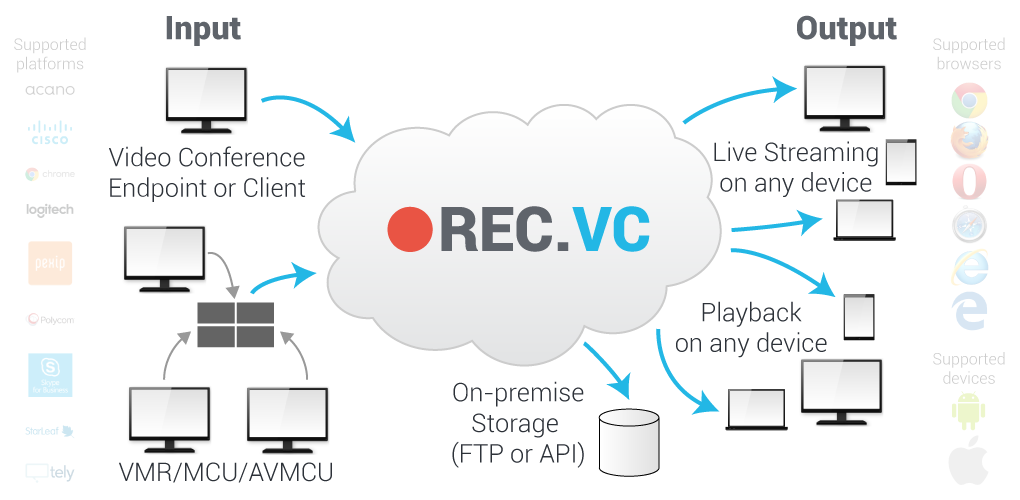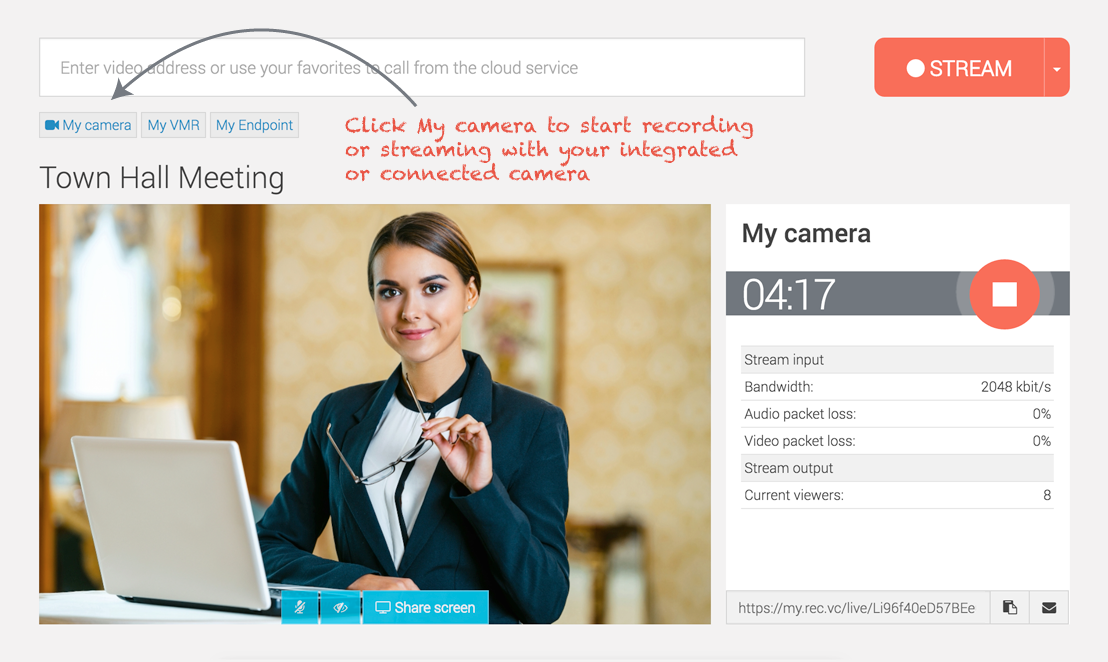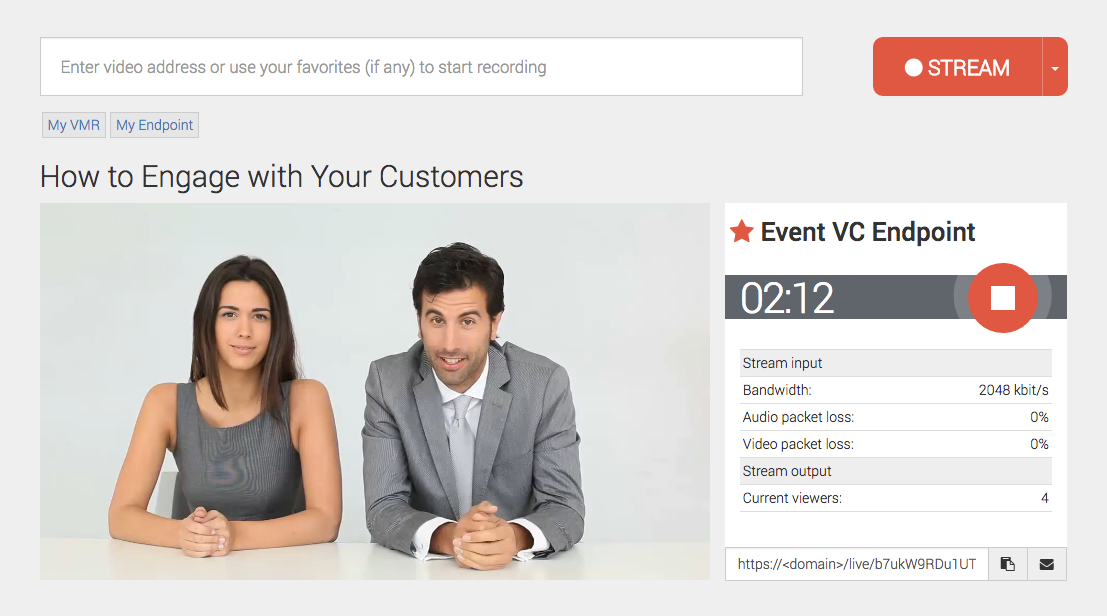Category: Live Streaming

January 19th, 2017 by admin
While many organizations, small and large, have begun to move as many services as possible to the cloud, so begins the move of their collaboration platform of choice.  While moving services such as documents and data began first and are an easier migration, moving video services to the cloud has been a bit slower.   However the last few years have seen an emergence of many top tier cloud video collaboration providers, making a transition from on-premise equipment and services more worthwhile.   As this shift gains more momentum there is one key collaboration component that is poised to make it’s leap to the cloud along with the rest; recording and streaming services.
There are many players in the recording and streaming space when it comes to video conferencing in enterprise. Â Likely the most notable is Cisco, with their Telepresence Content Server which came in the acquisition of Tandberg in 2009 and allowed users to dial an address to begin recording (and eventually streaming) video calls . Â Cisco has not made any major updates to TCS in years and has announced end-of-life.. Â
Additional players in the space include but are not limited to Polycom, with the RealPresence Media Suite as well as Lifesize, Qumu and Vbrick. Â However many providers do not offer cloud solutions at this time or are very early in their deployments, providing only limited cloud capability without requiring the customer to add on-premise equipment.
Why put Recording and Streaming in the Cloud?
The benefits of moving to the cloud have been increasingly clear. Â Flexibility, ease of scale, mobility, and less overhead are a few key factors out of many for migrating just about any business component away from on-premise. Â In terms of recording and streaming specifically storage is a major factor. Â As cameras and video technology improves, video files sizes are growing. Â Socially we have become more media centric and are creating more content than ever. Â Combine these two factors and storage capacity can disappear at an alarming rate . Â Why worry about continuously expanding the hardware storage in your data center when your cloud provider can do this for you? Â This is a big savings on gear and time spent on ordering, installing and maintaining it all. Â The ability to receive new features and services without having to worry about upgrades is a big plus as well.
In addition, playback and viewing of live streams of video meetings has naturally become more cloud-centric. Â In years past, most employees worked within the office and joined all-hands meetings in person or in connected conference rooms. Â These days the work force is dispersed and we all expect to be able to view recordings and streams on mobile. Â In the past this kind of viewing would have required a VPN connection back to the office among many other technical barriers. Â Today it makes sense that this function live in the cloud as it provides better ease of access for an increasingly mobile population. Â Â Let your provider handle storage, distribution, accessibility, and more so your IT staff can focus on more important things than maintaining a complicated network of on-premise servers connected to content delivery networks.
|
Feature
|
On-Premise
|
Cloud
|
| Encryption of recording and streaming sessions |
✓
|
✓
|
| Record from any device or platform |
Depends
|
✓
|
| Record out of the office while on the go |
Depends
|
✓
|
| Simple user creation and account management |
Depends
|
✓
|
| Easy scalability |
|
✓
|
| Automatic, worry-free backup |
|
✓
|
| Easy, secure, distributed delivery without additional assistance and cost from  a CDN |
|
✓
|
| Automatic updates and rollouts of new features |
|
✓
|
| Total cost of ownership |
High (opex and capex)
|
Low (opex only
|
Â
Recording and Streaming Cost of Ownership
This is a major factor when considering a move of recording and streaming services to the cloud.  Let’s do a quick breakdown. Â
Hardware Costs
Mentioned above, if your recording and streaming services are on premise, you’ll likely need multiple physical servers, especially for proper distribution across remote offices.  The bigger the and more distributed the deployment, the more servers you need.  This takes up rack space in your DC, requires power and cooling, but more impactfully, requires disaster recovery in place for backups and the possibility of server failure. Â
Staff Costs
Servers don’t run themselves.  You’ll need an IT person (or people) to manage all the above hardware as well as run upgrades and maintenance in an on-prem scenario.  You’ll need to watch out for things like capacity and storage and plan routine hardware refreshes to keep up. Normally these tasks fall on your network team or similar group, and don’t you pay these teams to do more important things like keep your network up and running?  Â
The Streaming Element
Streaming is becoming less of a nice to have and more of a requirement these days. Â On-premise streaming deployments are often complex and take up a lot of time of your network team and other IT staff. Â Managing the servers and network support to ensure a successful livestream is a huge time suck. Â You can leverage a CDN for this but this is also time spent and more cost on top of your on-premise costs .
It is clear that there is big savings in moving recording and streaming services to the cloud. These savings can be seen not just in your budget but in freeing valuable time of your staff to focus on more important tasks. Â
Recording and Streaming: Integrated vs Standalone?
Some collaboration cloud services have native recording & streaming functionality while others don’t.  If these services are important to you it makes sense to use a standalone recording and streaming service like REC.VC. This allows you to record from any device or platform.  With today’s volatile and ever improving collaboration market, it might take a few tries to find a service that properly fits the way your business operates.  Imagine having to switch or update your collaboration and having to learn and acclimate to a new recording platform along with everything else?  With REC.VC you can continue to record and live stream regardless of the collaboration platform or devices you’re using.  Agility at it’s best.

Recorded Content Control: One Platform vs. Many
With the increasing amount of collaboration tools emerging, businesses will often find employees using a multitude of non-company-standard apps and services, sometimes with overlapping features. Â Â Recording often falls into this category. Â This can be a huge complication. Â Competing services regularly have vastly different practices when it comes to recording. Â Some have different file formats, many require users to save recordings on their laptops while some could be stored on an unsecured server somewhere. Â This can become a real mess when you have company recordings spread all over the place and users with company issued computers running out of space on their hard drives or needing video files converted to other formats, Â subsequently calling IT for assistance. Â Â A cloud solution ensures all your recordings are secured in one place, no matter what device is used to create the content, all easily retrieved and accessible from any device while removing many troublesome IT obstacles.
In conclusion, it is somewhat of a surprise that most recording and streaming services were not cloud ready, and adopted sooner.  The benefits are many: increased mobility and ease of use for users, device and platform agnostic usage, easier deployment and management, lower overhead and associated costs in hardware and IT support, content control, and lots of flexibility.  The good news is that a robust, feature-rich, simple recording and streaming solution  is ready for you in the cloud with REC.VC.  Make your move today.
Posted in Live Streaming, Recording Tagged with: content server, media suite, recording, streaming
January 5th, 2017 by admin
Today we released the new user interface featuring
- Improved handling of the Source (select between Video Conference, Connected Camera (Google Chrome WebRTC) or Skype for Business) for your recording & streaming activity
- Easy switching between the two Modes available: Record-only and Stream & Record
- Better rendering on hand-held devices
New to REC.VC? Sign up for a 14 day free trial today!
We would like to thank all users that have tested the new recording & streaming user interface during its beta period.
The  release took place today during the REC.VC maintenance window (Thursdays, 6.00 – 8.00 AM GMT+1) and included all REC.VC sites (my.rec.vc and any white label site). The release did not cause any downtime or impact any ongoing recording & streaming sessions.
Posted in How to, Live Streaming, New features, Recording Tagged with: recording, skype for business, streaming, webrtc

August 5th, 2016 by admin
The video below shows how you easily can do a live stream directly from the popular Jamvee service using REC.VC, the global recording & streaming cloud service for video conferences.
New to REC.VC? Sign up for a free trial today
Jamvee users can start a REC.VC live streams of a Jamvee meeting in one of the following ways:
- From the REC.VC user interface call to <10-digit-pin>.vmr@jamvee.com
- From the Jamvee user interface call their personal REC.VC address <username>@rec.vc
The <10-digit-pin> refers to the Jamvee host or guest PIN code of your Jamvee virtual meeting room.
Need help? Contact support@rec.vc
Posted in How to, Live Streaming, Video clip Tagged with: live streaming, video conference live streaming

Wainhouse Research today published their review of the REC.VC recording & streaming cloud service:
Note: Access to this document requires a Wainhouse Research subscription.
Posted in Live Streaming, Press release, Recording, Uncategorized

New version of REC.VC released.
 Media Network Services (MNS), a global provider of value added cloud applications and network services for visual collaboration, today announced that a new version of REC.VC has been released. Users can with the new version record and stream video and desktop content to any device, directly from Google Chrome using e.g. any Logitech ConferenceCam.
Media Network Services (MNS), a global provider of value added cloud applications and network services for visual collaboration, today announced that a new version of REC.VC has been released. Users can with the new version record and stream video and desktop content to any device, directly from Google Chrome using e.g. any Logitech ConferenceCam.
“One year ago we revolutionized recording and streaming for video conferencing endpoints and virtual meeting rooms by making it easy, affordable and available in the cloud. Today we are proud to give the same one-click recording and streaming capability and experience to anyone with Google Chrome and a connected or integrated camera, “ says Kjell Oksendal, CMO and SVP Global Alliances at MNS.
REC.VC supported use cases range from recording of internal meetings, trainings, and recruitments, to live streaming of town hall meetings, customer events and quarterly financial presentations.
“We are pleased that MNS has joined the Logitech Collaboration Program†said Scott Wharton, general manager of Logitech’s video collaboration group. “MNS’ integration of REC.VC with Logitech ConferenceCams is designed to offer our joint customers simple and affordable recording and streaming for their video meetings.â€
REC.VC is leveraging the WebRTC framework to enable in-browser recording and streaming without plugins or third-party software download.
REC.VC is available as a cloud service with organization-wide subscription starting as low as $99 per month. 14 day free trial is available at www.rec.vc.
See also REC.VC User Help for additional information.
About MNS
Media Network Services (MNS) is a global provider of value added cloud applications for Visual Collaboration (VC). Products and services include QoS.VC the global network platform for VC, REC.VC Global Recording and Streaming Cloud Service, and IVR.VC Global Video IVR. See www.mns.vc for further details.
Posted in Live Streaming, Press release, Recording Tagged with: google chrome, logitech, recording, streaming, webrtc

Logitech and MNS Team to Deliver an Exceptional Recording & Live Streaming a Experience.
Media Network Services (MNS) today announced that it has joined the Logitech Collaboration Program (LCP) as an Integration partner in the program’s Complementary Technology Provider track. Announced last June, the LCP provides a unique framework for delivering high-quality video collaboration experiences across customer environments. Through the Logitech Collaboration Program, MNS augments the Logitech solutions to provide a more complete and enhanced user experience that is optimized for groups to collaborate anytime and anywhere.
“We have joined the Logitech Collaboration Program as we want to provide MNS REC.VC users with a seamless experience when using Logitech ConferenceCams†says Kjell Oksendal, CMO and SVP Global Alliances at MNS. â€In the very near future, any REC.VC user with a Logitech ConferenceCam can with one click capture and live stream any meeting, training session or quarterly presentation.â€
“We are pleased that MNS has joined our program†said Scott Wharton, general manager of Logitech’s video collaboration group. “By closely collaborating with MNS, we are able to offer a better user experience to our joint customers.â€
Posted in Channel, Live Streaming, Press release, Recording Tagged with: logitech
April 21st, 2016 by admin
Today during the REC.VC maintenance window (Thursday, 6.00 – 8.00 AM CEST) we released a new feature enabling REC.VC users to use their existing calendar applications to schedule REC.VC live streaming events. The new calendar feature is available when creating / editing a live stream and creates a calendar event with Live Stream Title and Live Stream URL populated by REC.VC.

When clicking on the Calendar icon users can choose between Google Calendar, Yahoo! Calendar and Outlook Calendar, in addition to the standard iCal Calendar format. The date and time of the event is by default set to +24 hours, but this can easily be changed in the calendar application before sending out the calendar invitation.
The release included all REC.VC sites (my.rec.vc and any white label site) and caused no downtime for users.
Posted in Live Streaming, New features

March 30th, 2016 by admin
We are pleased to announce a new version of REC.VC scheduled for release on Thursday, March 31st between 06.00 AM and 08.00 AM CEST (during our maintenance window), with the following highlights:
- Create and manage any number of live streams
- Share live stream links with your viewers
- Activate and start a live stream with ease
Doing a live streaming to any device directly from your video conference endpoint, client or virtual meeting room has never been easier.
The new release also enables users to easily switch between (1) record mode and (2) live streaming & record mode.
While REC.VC Live Streaming is an add-on subscription to the REC.VC Recording base subscription, we invite all users to test live streaming for free throughout the month of April (2016), limited to 10 Live Streaming View Hours (e.g: 2 live streaming events x 30 minutes x 10 viewers).
See also REC.VC User Help Documentation for details on the new streaming features.
The release includes all REC.VC sites (my.rec.vc and any white label site).
There is no downtime expected with the release.
Please contact support@rec.vc in case you have any question about the new features.
Related posts:
Posted in Live Streaming, New features Tagged with: live streaming

March 14th, 2016 by admin
REC.VC enables you to live stream to any device directly from your video conference endpoint or virtual meeting room. We will in this blog post explain how you can embed a live stream on your site, e.g. a corporate website, corporate intranet, or customer portal.New to REC.VC? Sign up for a free trial here.
The REC.VC live stream link (which you share with the viewers) is based on the following syntax:
https://<site>/live/<stream-id>
<site> is the (sub)domain you go to when accessing the REC.VC service
<stream-id> is an auto-generated unique stream identifier consisting of 16 case-sensitive alphanumeric characters.
In case you are using the REC.VC branded site, the live stream link is as follow:
https://my.rec.vc/live/<stream-id>
In case you are using a white label site, you can replace <site> with the (sub)domain that you use when logging into your white label site as a REC.VC user. Many white label partners use rec.<domain> as their white label site.
To embed a live stream on your site, all you have to do is to place the following script somewhere within the <body> of a html page:
<script src="https://<site>/live/js/<stream-id>.js"></script>
Let’s say that we wanted to embed the following live stream in this blog post:
https://my.rec.vc/live/W4tgm30jT2VpUUlH
The script for this live stream based on the above syntax is as follows:
<script src="https://my.rec.vc/live/js/W4tgm30jT2VpUUlH.js"></script>
We have below added the script directly in the HTML code:
Note: The live stream above will most of the time be inactive as we will not keep the live stream up 24/7.
Posted in Live Streaming, New features Tagged with: embed, live streaming, white label